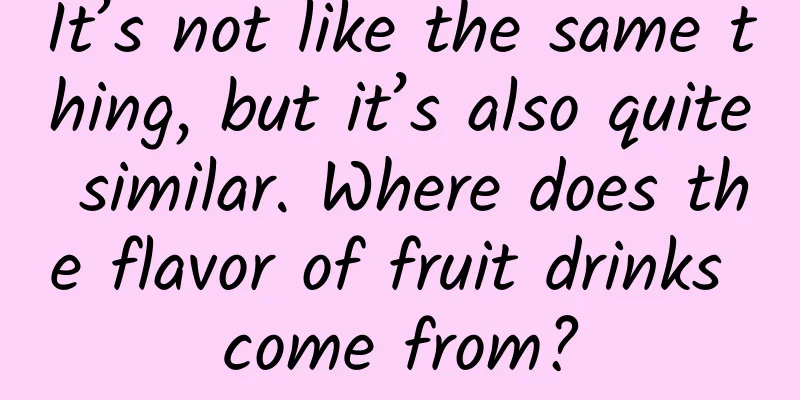It’s not like the same thing, but it’s also quite similar. Where does the flavor of fruit drinks come from?

|
Review expert: Wang Guoyi, Postdoctoral Fellow in Nutrition and Food Safety, China Agricultural University Orange, lemon, strawberry, cherry, grape... Perhaps it is because seeing fruit-flavored drinks reminds us of the natural fruit aromas that bring us good memories. When shopping, when you see a variety of dazzling fruit-flavored drinks, you always can't help but want to buy them to try. But after opening the bottle cap and taking a sip, my mind suddenly became clear and I started to doubt. Although the taste can be said to be 90% similar, the drink in my mouth is somewhat similar to the real fruit, but to say that it is exactly the same, it is not quite the same. Source: pexels What is going on? The development history of food flavors If you look at the ingredient list of fruit-flavored drinks, you will find that most of them do not contain the corresponding fruit juice or fruit pulp, but instead contain artificial edible flavors that imitate the taste of a certain fruit. Source: pexels Everyone likes natural aromas, and natural aromas are indeed very rich, but from a scientific and technological perspective, there are very few natural spices that can be directly extracted from animals and plants and widely used in food. With the improvement of living standards, people's requirements for food taste are getting higher and higher, and only foods with rich and not monotonous flavors can make consumers pay. Today, the variety and quantity of edible flavors used in daily life have far exceeded the variety and output of natural spices . Not only that, sometimes people's requirements for food taste and aroma also exceed the flavor production capacity of natural spices themselves. For example: if you add some lemon juice to beer or cola to give these drinks a lemon flavor, this is still within the range that natural flavors can support. But if you want to taste "sakura flavored cola", "copper pot shabu-shabu flavored potato chips" or "yuzu chili flavored chocolate", then it is obviously not something that can be easily mixed with natural flavors in the conventional sense. Source: pexels So gradually, as a huge supplement to natural flavors, edible flavors have become an indispensable additive in the food industry with the advantages of acceptable cost, controllable concentration and feasible process. Although people are not very accepting of the dependence on edible flavors, a closer look will reveal that in modern society, in addition to fresh fruits, vegetables, meat, eggs and milk, almost all other foods have long been inseparable from various edible flavors. Why doesn't it taste like real fruit? The orange, lemon, strawberry and other flavored beverages we often drink are not that different from the taste of real fruits, and are quite widely accepted by the public. But some less common flavors, such as cherry-flavored drinks, can't even be said to taste exactly like cherries, and can be said to be completely unrelated. Source: pexels Some people think it smells like paint, some people think it smells a bit like bitter almonds. Although the subjective feelings are different, none of them will feel that it smells like the cherry fruit we remember. So some people are going to complain, we have already accepted edible flavors for food safety, but can't edible flavors imitate the taste a little more similar? Source: pexels I have to say it is a bit difficult. Because the composition of natural fruit aroma is very complex, there are dozens of chemical components in it. If all of them are in accordance with the proportion of nature, the cost of artificial preparation will be too high. Therefore, perfumers generally only focus on a few main ingredients to prepare fragrances. It is not surprising that the fragrance is not exactly the same as the natural fruit flavor. Can the taste of food flavors be improved? With the development of science and technology, the taste of edible flavors can certainly be improved to make them closer and closer to the taste they imitate, but this may require long-term and continuous efforts. According to statistics from relevant experts, the technical level of my country's flavor industry has lagged behind that of foreign counterparts by about 20 years. Many spices need to be purchased from abroad at high prices, so the cost of blending edible flavors has increased, and the taste has to be reduced. On the one hand, due to technical limitations, it is impossible to confirm the structure of the main components of a certain flavor; on the other hand, even if it is confirmed, due to cost control, many spices will not be used for blending. Source: pexels In addition, the scarcity of perfumers is also a problem. The research and development of new spices and flavors depends entirely on the blending of perfumers. The training of perfumers requires not only the investment of time and money, but also depends on the person's talent. According to an interview with Professor Sun Baoguo of the Fragrance and Flavor Department of Beijing University of Technology, this major has been around for more than 40 years, and there are only "two and a half people" in the school who can be called perfumers (title). They are students taught by the professor, and the professor joked that he is not a perfumer and is far worse than one. The process from developing a new flavor and fragrance to finally applying it to the product is quite time-consuming and usually takes about two years. First of all, food safety must be ensured to prove that new spices and flavors are harmless to the human body; then perfumers are asked to develop new fragrance products based on market demand; then samples are given to food processing factories to produce samples; samples need to be trial-sold and require consumer tasting and feedback. Only when consumers think that the product tastes good and have the desire to buy it will the food factory order flavors from the flavor factory, and the flavor factory will order spices from the spice factory. Source: pexels In short, the development and improvement of edible flavors not only requires technological advancement and talent cultivation within the industry, but also depends on the development of the entire industrial chain. In the past, people only had a single, monotonous beverage flavor to choose from, but now there is a dazzling array of beverages with different fruit flavors to choose from. This is inseparable from the development of edible flavors as additives in beverages; it continues to enrich the taste of food and satisfy everyone's better life. Sometimes the taste experience it brings us may be unsatisfactory, but we might as well give it more time and patience for its development and progress. |
>>: What enlightenment can the insomniac eyeless fish bring us?
Recommend
Hamburger button transition animation implemented in Swift
Source code introduction: A beautiful hamburger b...
The more you walk, the lower your risk of death?
Insufficient physical activity affects more than ...
Win10 pushes new features: make your computer faster
Computer lag is often the most headache problem f...
They sold you cancer, but said it was a way to keep healthy.
This article was reviewed by Pa Li Ze, chief phys...
Are mutton skewers made of mink, cat, or mouse? After testing 13 types, the results were a complete failure!
Put down the skewers in your hand! What you are e...
How to use Zhihu to divert private domain traffic?
In this era of prevalence of self-media and unive...
Just three steps to let you play Hammer phone "Big Bang"
Whether it is business office, online social netw...
Brand Promotion and Marketing: How to market the Avengers and Labor Day together?
May Day is here in the blink of an eye. This arti...
I'm EMO! I feel sad when autumn comes. Does "autumn sadness syndrome" really exist?
Review expert: Peng Guoqiu, deputy chief physicia...
10 Mother’s Day copywriting ideas!
This Sunday, May 13th, is Mother’s Day . Are copy...
After driving away the police, Starbucks announced a price increase. How long can it continue to be arrogant in the country?
Starbucks’ “high-end” label in the country is bei...
Michigan government uses VW compensation to promote ZEV development
According to foreign media reports, the Michigan ...
Can long-term coffee drinking help you lose weight? Can it help you have a bowel movement? Huaxi experts reveal 4 truths, forward and save~
Can long-term coffee drinking help you lose weigh...
Lighthouse inheritance | Ye Shuhua, "Mother of Beijing Time": Every star has its own light
Have you heard of "Beijing Time"? Ye Sh...
Scientists plan to build a "warehouse" on the moon to preserve the "spark" of life
At a time when Earth's biodiversity is increa...









